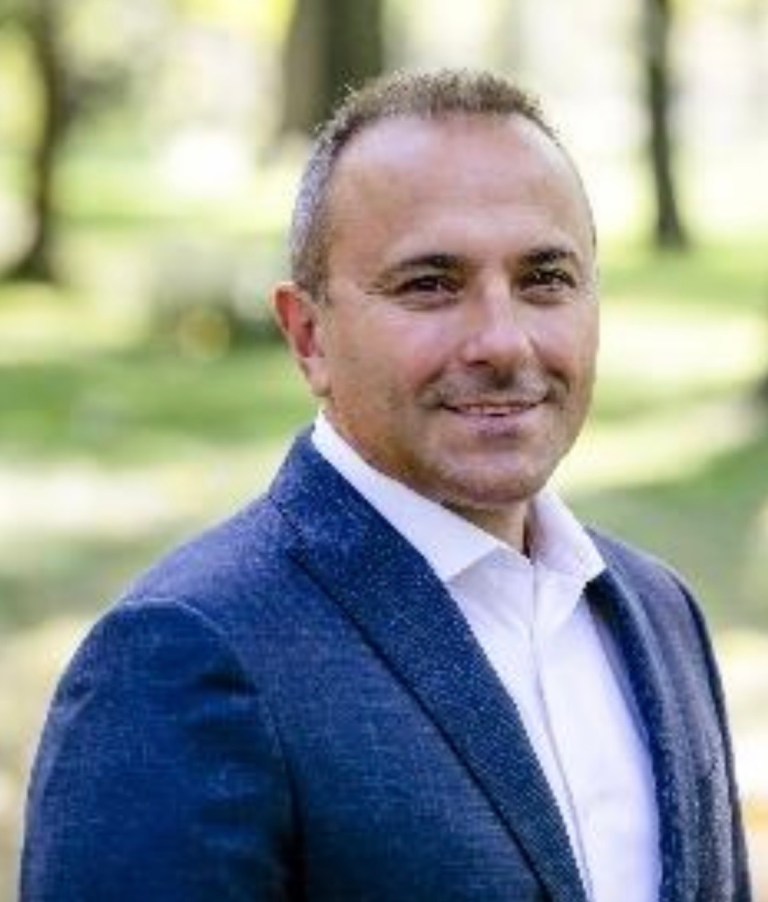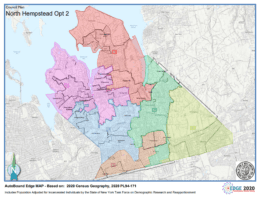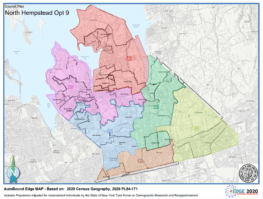
Mineola Mayor Paul Pereira has spoken out against the redistricting proposals that would separate the village and remove Councilman Dennis Walsh from North Hempstead’s District 3.
“I cannot support any plan that splits Mineola’s district and strongly urge all members of the Town Board to keep our village whole,” Pereira said Monday in a news release.
The North Hempstead Town Board will consider at its June 16 meeting four redistricting proposals submitted by the town’s nonpartisan redistricting commission.
Of the four options, two put a portion of the village into District 2, represented by Democratic Councilman Peter Zuckerman. The third option would give a small piece of the village to Democrat Robert Troiano’s District 1, removing Walsh from District 3, which he currently represents.
David Adhami, of District 5, would be removed in three of the options while Walsh would be removed in two.
One of the proposals would remove both Adhami and Walsh.
“A village trustee from 2013 until 2021, Councilman Walsh, an ever-present member at village and Town Board meetings even prior to becoming a trustee, spoke his mind and fought for what he thought was best for village residents,” Pereira said. “By breaking up the village, we will be losing a singular voice that will have the best interest of our entire community at heart, regardless of race, creed, religion or political affiliation.”
Town Democrats, who hold a four-person majority on the seven-member board, would be unaffected by all four proposals. In a statement to Blank Slate Media, Democratic Councilwoman Veronica Lurvey said the Town Board is committed to picking the map “that best reflects the goals and principles of redistricting.”
“The Town Board is carefully reviewing all four map options presented by the Nonpartisan Temporary Redistricting Commission in their report. The commission was advised by experts and put a lot of work and careful thought into the options presented, and we thank them for that,” Lurvey said. “We are committed to choosing the one map option that best reflects the goals and principles of redistricting, including the creation of an Asian minority majority district. We will listen to the residents, including Mayor Pereira, at the public hearing on June 16 before moving forward with any option.”
The proposals were made by the redistricting commission May 30 following three public hearings in May where residents could give comments and suggestions. In February, Democrats voted to establish the seven-member commission where each councilperson would appoint one person. The action represented a change from a decade ago when Jon Kaiman, then the town supervisor, had two additional picks, totaling nine for the commission.
The board consists of Chairperson Dana Boylan, Vice Chair Harrison Feuer, Secretary Jill Wasser, Mary Kay Barket, Sumeet Datt, James McHugh and Patricia Schneider.
Every 10 years, the town is directed to participate in the redistricting process by town code in order to revise districts to ensure none contain a substantially disproportionate difference in the voter population compared to other districts. This ritual is based on the latest U.S. Census, conducted every 10 years.
As it stands, North Hempstead currently has six councilmanic districts, which are each represented by one member of the Town Board. In addition to the six elected officials, the town supervisor also sits on the seven-member board.
According to the 2020 federal census, which was released on Aug. 12, 2021, the Town of North Hempstead’s population grew by 11,317 people to 237,639. This is a 5 percent increase from the 2010 Census, which listed the Town’s population as 226,322.
The four proposals, labeled as Options 1, 2, 3 and 9, respectively will be on the June 16 agenda.
Members of the Town Board can vote and confirm one of the proposals at the June meeting or they can also choose to continue any discussions in the future.
For Option 1, District 1 remains the same and adds a small portion of Roslyn Heights to meet the population requirements.
District 2 would lose East Williston, Manhasset Hills, Herricks and parts of Roslyn Heights while gaining North Hills and parts of Mineola.
District 3 would lose parts of Mineola and Garden City Park while gaining East Williston, parts of Floral Park and North New Hyde Park.
District 4 would lose Saddle Rock, Great Neck Estates, parts of both Floral Park and North New Hyde Park, Saddle Rock Estates and Harbor Hills while gaining Manhasset Hills Herricks and Garden City Park.
District 5 would lose North Hills Roslyn and Roslyn Estates while gaining Munsey Park, Plandome Manor, Plandome Heights, Saddle Rock, Great Neck Estates, Saddle Rock Estates and Harbor Hills.
District 6 would lose the villages of Plandome Manor, Plandome, Plandome Heights and Munsey Park while gaining Roslyn and Roslyn Estates.

Option 1’s largest population would be District 5 with 3 being its smallest.
For Option 2, District 1 loses nothing while a “small portion” of Mineola. District 2 would lose East Williston, Manhasset Hills, and parts of Herricks while gaining parts of Mineola.
District 3 would lose parts of Mineola and Garden City Park while gaining East Williston and parts of both Floral Park and North New Hyde Park.
District 4 would lose Saddle Rock, Great Neck Estates, and parts of Floral Park, North New Hyde Park, Saddle Rock Estates and Harbor Hills while gaining North Hills, Manhasset Hills, Garden City Park and part of Herricks.
District 5 would lose North Hills, Roslyn and Roslyn Estates while gaining Munsey Park, Plandome Manor, Plandome, Plandome Heights, Saddle Rock, Great Neck Estates, Saddle Rock Estates and HarborHills.
District 6 would lose Plandome Manor, Plandome, Plandome Heights, and Munsey Park while gaining Roslyn and Roslyn Estates.

The largest and smallest district in Option 2 would be 3 and 1, respectively.
For Option 3, District 1 would only add a portion of Mineola whereas District 2 would lose part of Garden City Park and gain Roslyn.
District 3 would lose a piece of Mineola while gaining nothing.
District 4 would only gain a small part of Garden City Park. District 5 would lose the village of Roslyn while gaining Munsey Park and District 6 would lose Munsey Park and gain nothing

The largest and smallest districts in Option 3 would be 4 and 6, respectively.
If approved, Options 2 and 3 would remove Councilman Dennis Walsh, who lives in Mineola and District 3, out of his current district.
For Option 9, District 1 doesn’t lose anything but gains a small part of Roslyn Heights. District 2 would lose part of Garden City Park, Manhasset Hills and Herricks while gaining Williston Park and Roslyn.
District 3 would lose Williston Park and gain part of Garden City Park, North New Hyde Park and parts of Floral Park.
District 4 would lose Saddle Rock, Great Neck Estates, Saddle Rock Estates, Harbor Hills and parts of Floral Park and North New Hyde Park while gaining North Hills, Manhasset Hills and Herricks.
District 5 would lose North Hills and Roslyn while gaining Munsey Park, Saddle Rock, Great Neck Estates, Saddle Rock Estates and Harbor Hills.
District 6 would only lose Munsey Park while not gaining anything.

For Option 9, the largest and smallest districts would be Districts 4 and 6, respectively.
Hearings for the nonpartisan redistricting commission were held in May at North Hempstead Town Hall, Clinton G. Martin Park, and the ‘Yes We Can’ Community Center where they considered public comments both in-person and online and were guided on state, town and federal laws.
The public hearing for redistricting will be held on Thursday, June 16.
More information on the town’s redistricting can be found on the town’s website.






